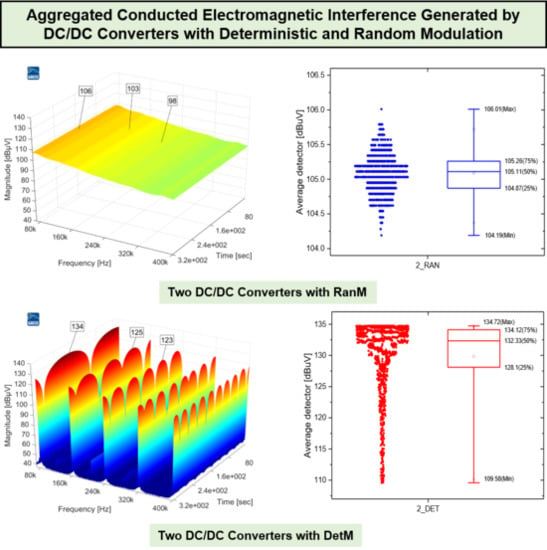Aggregated Conducted Electromagnetic Interference Generated by DC/DC Converters with Deterministic and Random Modulation
Abstract
1. Introduction
2. Simulation Results of Aggregated EMI Generated by DC/DC Converters with Deterministic and Random Modulation
3. Measurements of Aggregated EMI Generated by DC/DC Converters with Deterministic and Random Modulation
4. Statistical Analyses of Aggregated EMI Generated by Converters with Deterministic and Random Modulation Measured According to Standards
5. Conclusions
Author Contributions
Funding
Conflicts of Interest
Abbreviations
| AV | Average |
| CISPR | International Special Committee on Radio Interference |
| DetM | Deterministic Modulation |
| EM | ElectroMagnetic |
| EMC | ElectroMagnetic Compatibility |
| EMI | ElectroMagnetic Interference |
| EUT | Equipment Under Test |
| FPGA | Filed-Programmable Gate Array |
| IEC | International Electrotechnical Commission |
| IFBW | Intermediate Frequency Band Width |
| Probability Density Function | |
| QP | Quasi Peak |
| RanM | Random Modulation |
| STFT | Short-Time Fourier Transform |
References
- Braun, S.; Donauer, T.; Russer, P. A real-time time-domain EMI measurement system for full-compliance measurements according to CISPR 16-1-1. IEEE Trans. Electromagn. Compat. 2008, 50, 259–267. [Google Scholar] [CrossRef]
- Loschi, H.; Ferreira, L.; Nascimento, D.; Cardoso, P.; Carvalho, S.; Conte, F. EMC Evaluation of Off-Grid and Grid-Tied Photovoltaic Systems for the Brazilian Scenario. J. Clean Energy Technol. 2018, 6, 125–133. [Google Scholar] [CrossRef]
- Capovilla, C.E.; Casella, I.R.S.; Sguarezi Filho, A.J.; dos Santos Barros, T.A.; Ruppert Filho, E. Performance of a direct power control system using coded wireless OFDM power reference transmissions for switched reluctance aerogenerators in a smart grid scenario. IEEE Trans. Ind. Electron. 2014, 62, 52–61. [Google Scholar] [CrossRef]
- Ma, X.; Zhang, Q.; Luo, Z.; Lin, X.; Wu, G. A novel structure of Ferro-Aluminum based sandwich composite for magnetic and electromagnetic interference shielding. Mater. Des. 2016, 89, 71–77. [Google Scholar] [CrossRef]
- Alam, A.; Mukul, M.K.; Thakura, P. Wavelet transform-based EMI noise mitigation in power converter topologies. IEEE Trans. Electromagn. Compat. 2016, 58, 1662–1673. [Google Scholar] [CrossRef]
- Pyda, D.; Habrych, M.; Rutecki, K.; Miedzinski, B. Analysis of narrow band PLC technology performance in low-voltage network. Elektron. Elektrotechnika 2014, 20, 61–64. [Google Scholar] [CrossRef]
- Shadare, A.E.; Sadiku, M.N.; Musa, S.M. Electromagnetic compatibility issues in critical smart grid infrastructure. IEEE Electromagn. Compat. Mag. 2017, 6, 63–70. [Google Scholar] [CrossRef]
- Smolenski, R.; Bojarski, J.; Kempski, A.; Lezynski, P. Time-domain-based assessment of data transmission error probability in smart grids with electromagnetic interference. IEEE Trans. Ind. Electron. 2013, 61, 1882–1890. [Google Scholar] [CrossRef]
- Lezynski, P.; Smolenski, R.; Loschi, H.; Thomas, D.; Moonen, N. A novel method for EMI evaluation in random modulated power electronic converters. Measurement 2020, 151, 107098. [Google Scholar] [CrossRef]
- Lezynski, P. Random modulation in inverters with respect to electromagnetic compatibility and power quality. IEEE J. Emerg. Sel. Top. Power Electron. 2017, 6, 782–790. [Google Scholar] [CrossRef]
- Lai, Y.S.; Chen, B.Y. New random PWM technique for a full-bridge DC/DC converter with harmonics intensity reduction and considering efficiency. IEEE Trans. Power Electron. 2013, 28, 5013–5023. [Google Scholar] [CrossRef]
- Chatterjee, S.; Garg, A.K.; Chatterjee, K.; Kumar, H. Chaotic PWM spread spectrum scheme for conducted noise mitigation in DC-DC converters. In 2015 International Conference on Energy, Power and Environment: Towards Sustainable Growth (ICEPE); IEEE: Piscataway, NJ, USA, 2015; pp. 1–6. [Google Scholar]
- Marsala, G.; Ragusa, A. Spread spectrum in random PWM DC-DC converters by PSO&GA optimized randomness levels. In Proceedings of the 2017 IEEE 5th International Symposium on Electromagnetic Compatibility (EMC-Beijing), Beijing, China, 28–31 October 2017; IEEE: Piscataway, NJ, USA, 2017; pp. 1–6. [Google Scholar]
- Gamoudi, R.; Chariag, D.E.; Sbita, L. A Review of Spread-Spectrum-Based PWM Techniques—A Novel Fast Digital Implementation. IEEE Trans. Power Electron. 2018, 33, 10292–10307. [Google Scholar] [CrossRef]
- Liou, W.R.; Villaruza, H.M.; Yeh, M.L.; Roblin, P. A digitally controlled low-EMI SPWM generation method for inverter applications. IEEE Trans. Ind. Informatics 2013, 10, 73–83. [Google Scholar] [CrossRef]
- Jing, H.; Weiying, Z.; Jinhong, L. Study on improving EMC of APFC converter with chaotic spread-spectrum technique. In Proceedings of the 2017 IEEE 2nd Advanced Information Technology, Electronic and Automation Control Conference (IAEAC), Chongqing, China, 25–26 March 2017; IEEE: Piscataway, NJ, USA, 2017; pp. 433–437. [Google Scholar]
- Arunkumari, T.; Indragandhi, V. An overview of high voltage conversion ratio DC-DC converter configurations used in DC micro-grid architectures. Renew. Sustain. Energy Rev. 2017, 77, 670–687. [Google Scholar] [CrossRef]
- Chen, Y.; Ma, D.B. EMI-Regulated GaN-Based Switching Power Converter With Markov Continuous Random Spread-Spectrum Modulation and One-Cycle on-Time Rebalancing. IEEE J. Solid-State Circuits 2019, 54, 3306–3315. [Google Scholar] [CrossRef]
- Ho, E.N.Y.; Mok, P.K.T. Design of PWM Ramp Signal in Voltage-Mode CCM Random Switching Frequency Buck Converter for Conductive EMI Reduction. IEEE Trans. Circuits Syst. I: Regul. Pap. 2013, 60, 505–515. [Google Scholar] [CrossRef]
- Loschi, H.; Lezynski, P.; Smolenski, R.; Nascimento, D.; Sleszynski, W. FPGA-Based System for Electromagnetic Interference Evaluation in Random Modulated DC/DC Converters. Energies 2020, 13, 2389. [Google Scholar] [CrossRef]
- Legowski, S.; Trzynadlowski, A.M. Hypersonic MOSFET-based power inverter with random pulse width modulation. In Proceedings of the Conference Record of the IEEE Industry Applications Society Annual Meeting, San Diego, CA, USA, 1–5 October 1989; Volume 1, pp. 901–903. [Google Scholar]
- Bendicks, A.; Dörlemann, T.; Frei, S.; Hees, N.; Wiegand, M. Active EMI reduction of stationary clocked systems by adapted harmonics cancellation. IEEE Trans. Electromagn. Compat. 2018, 61, 998–1006. [Google Scholar] [CrossRef]
- Smolenski, R.; Bojarski, J.; Kempski, A.; Luszcz, J. Aggregated conducted interferences generated by group of asynchronous drives with deterministic and random modulation. In Proceedings of the 2012 Asia-Pacific Symposium on Electromagnetic Compatibility, Singapore, 21–24 May 2012; pp. 293–296. [Google Scholar]
- Smolenski, R.; Lezynski, P.; Bojarski, J.; Drozdz, W.; Long, L.C. Electromagnetic Compatibility Assessment in Multiconverter Power Systems-Conducted Interference Issues. Measurement 2020. [Google Scholar] [CrossRef]
- Schmidt, S.; Richter, M.; Oberrath, J.; Mercorelli, P. Control oriented modeling of DCDC converters. IFAC-PapersOnLine 2018, 51, 331–336. [Google Scholar] [CrossRef]
- The European Parliament and the Council. Directive 2014/30/EU on the harmonisation of the laws of the Member States relating to electromagnetic compatibility. Off. J. Eur. Union 2014, L96, 79–106. [Google Scholar]
- Bojarski, J.; Smolenski, R.; Kempski, A.; Lezynski, P. Pearson’s random walk approach to evaluating interference generated by a group of converters. Appl. Math. Comput. 2013, 219, 6437–6444. [Google Scholar] [CrossRef]
- International Electrotechnical Commission. Specification for radio disturbance and immunity measuring apparatus and methods—Part 1-1: Radio disturbance and immunity measuring apparatus—Measuring apparatus. In CISPR 16-1-1:2019; IEC: Geneva, Switzerland, 2019. [Google Scholar]
- Ferrero, A.; Petri, D.; Carbone, P.; Catelani, M. EMC Measurements. In Modern Measurements: Fundamentals and Applications; Wiley: Hoboken, NJ, USA, 2015; pp. 317–351. [Google Scholar]
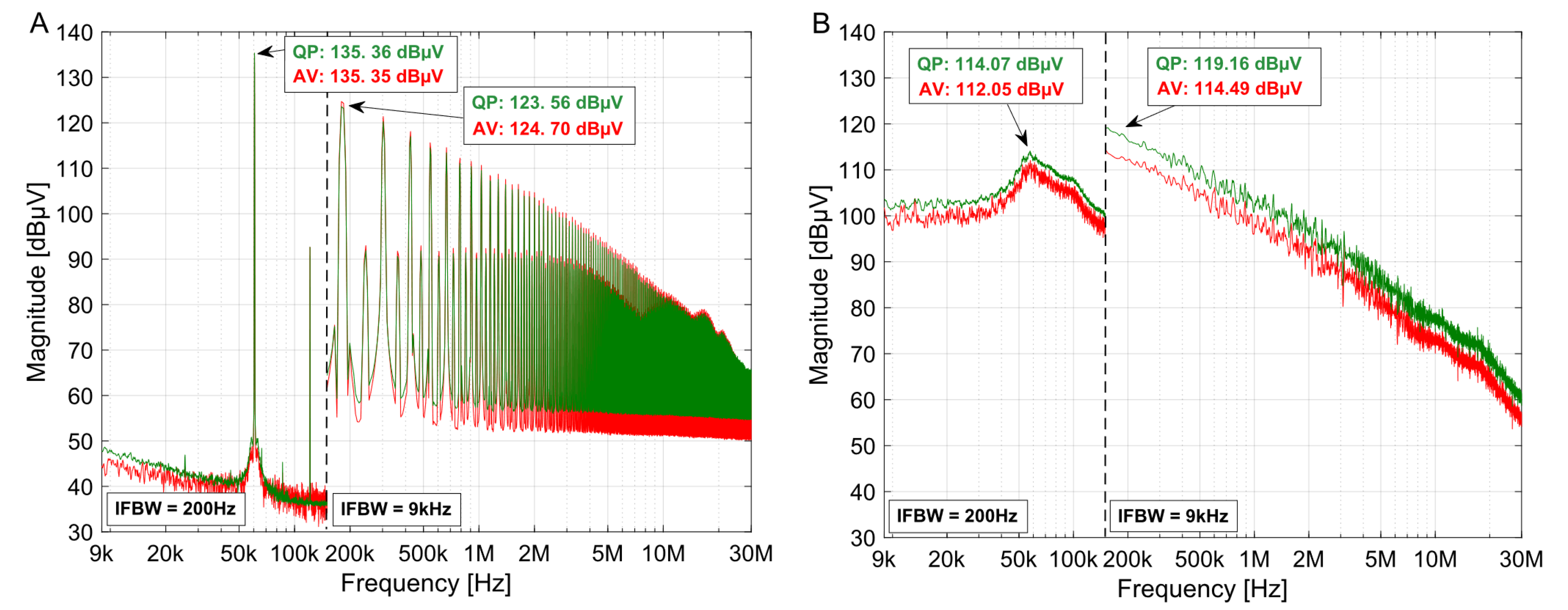
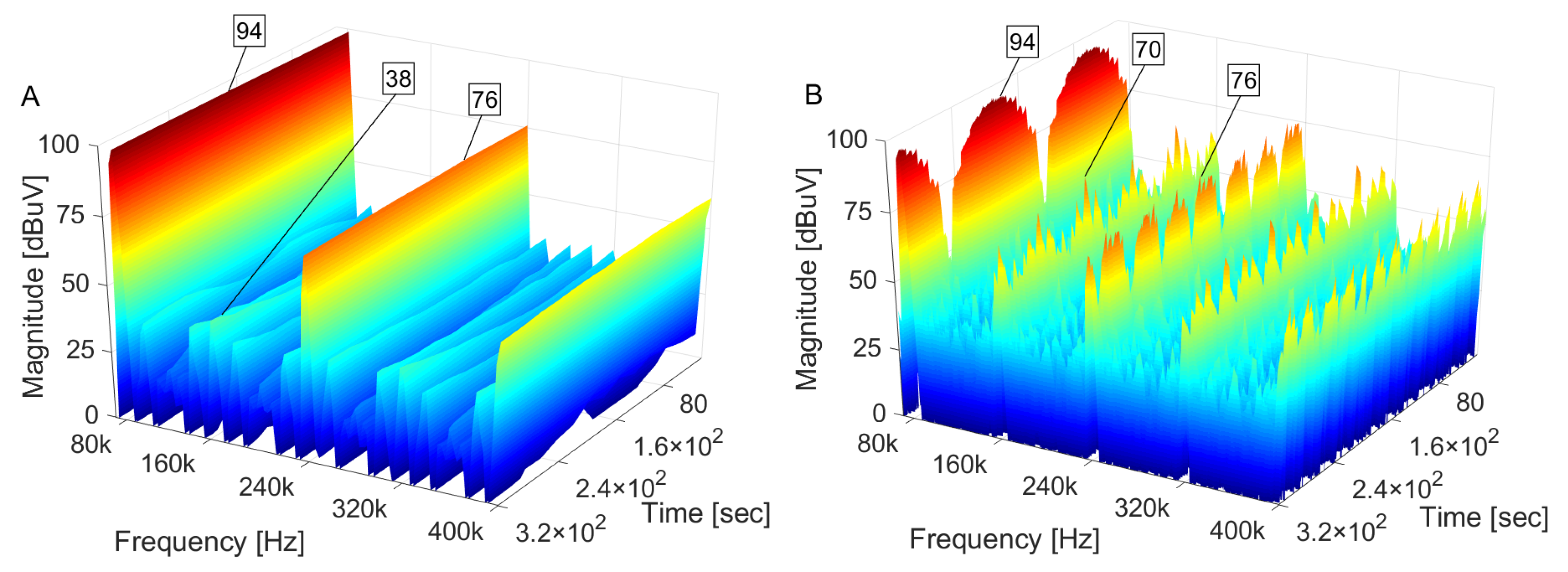
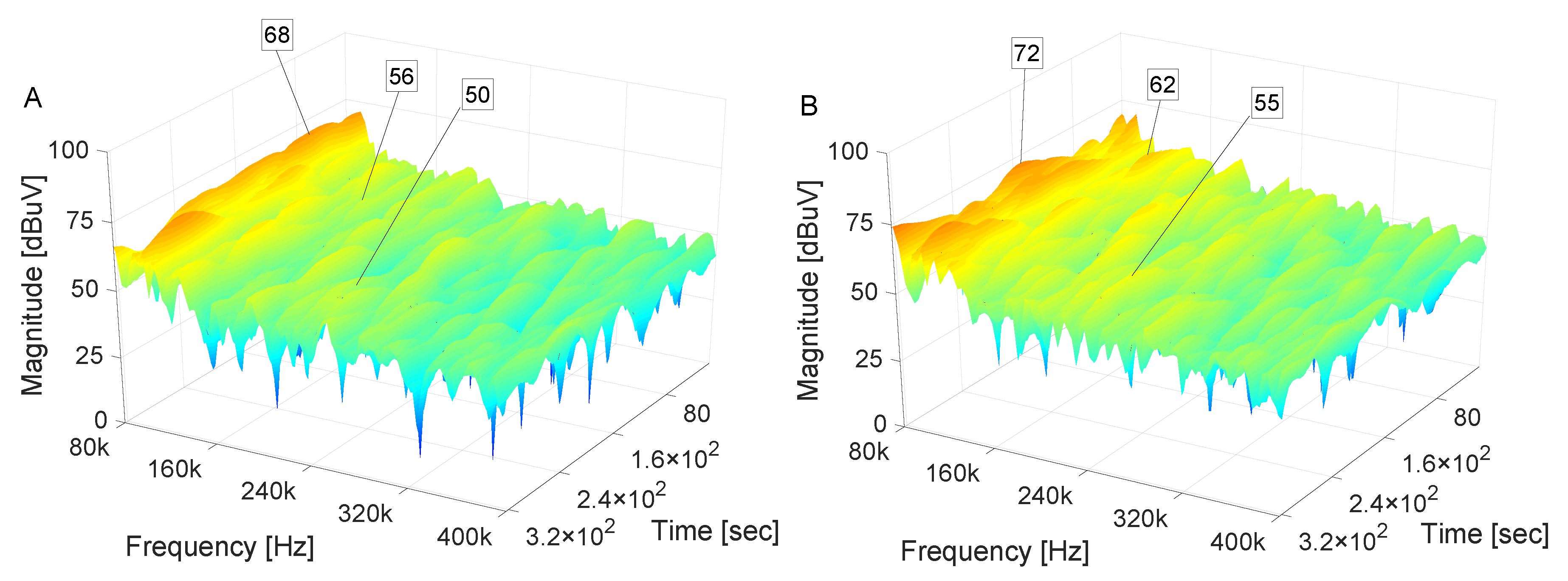
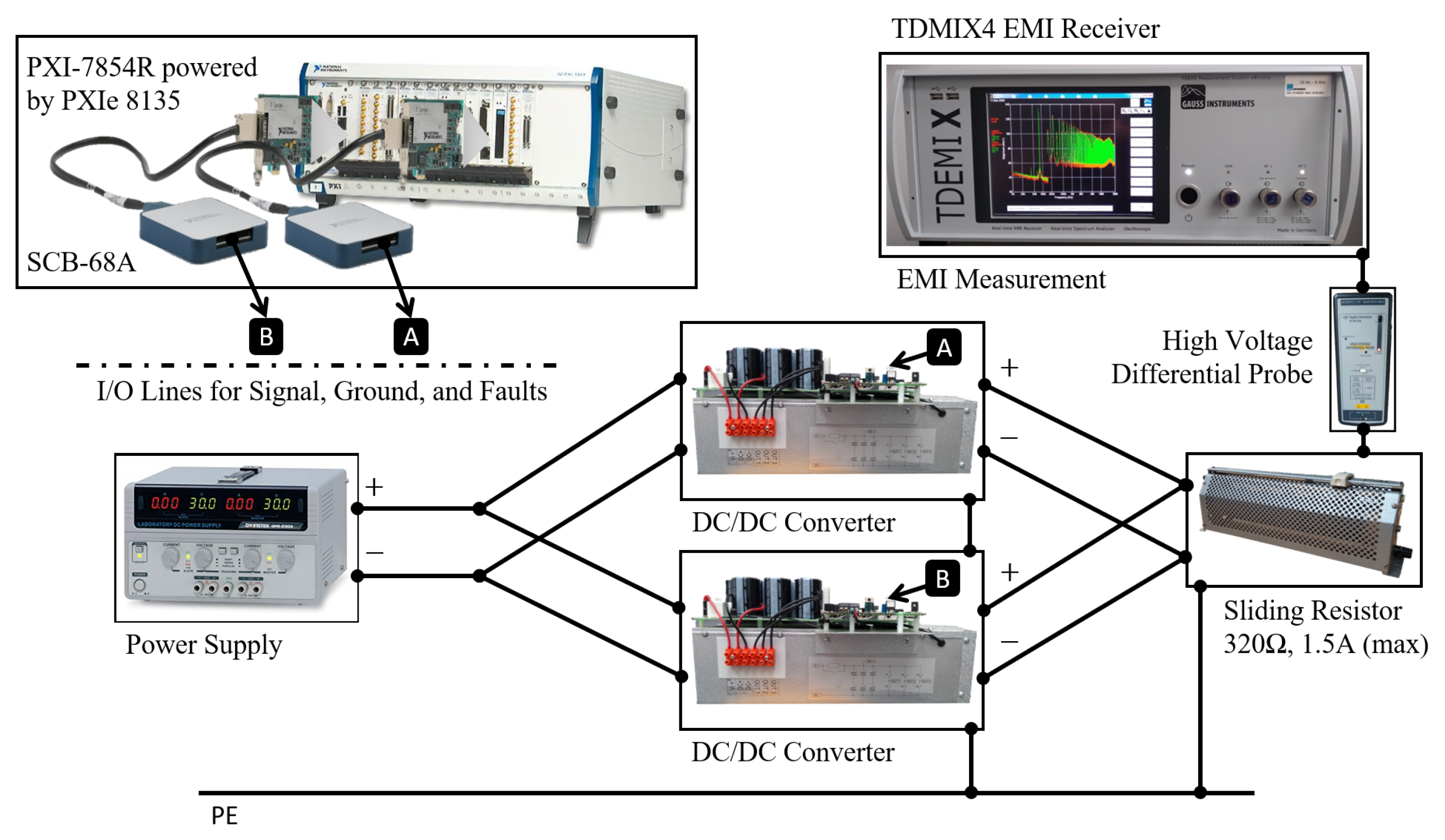
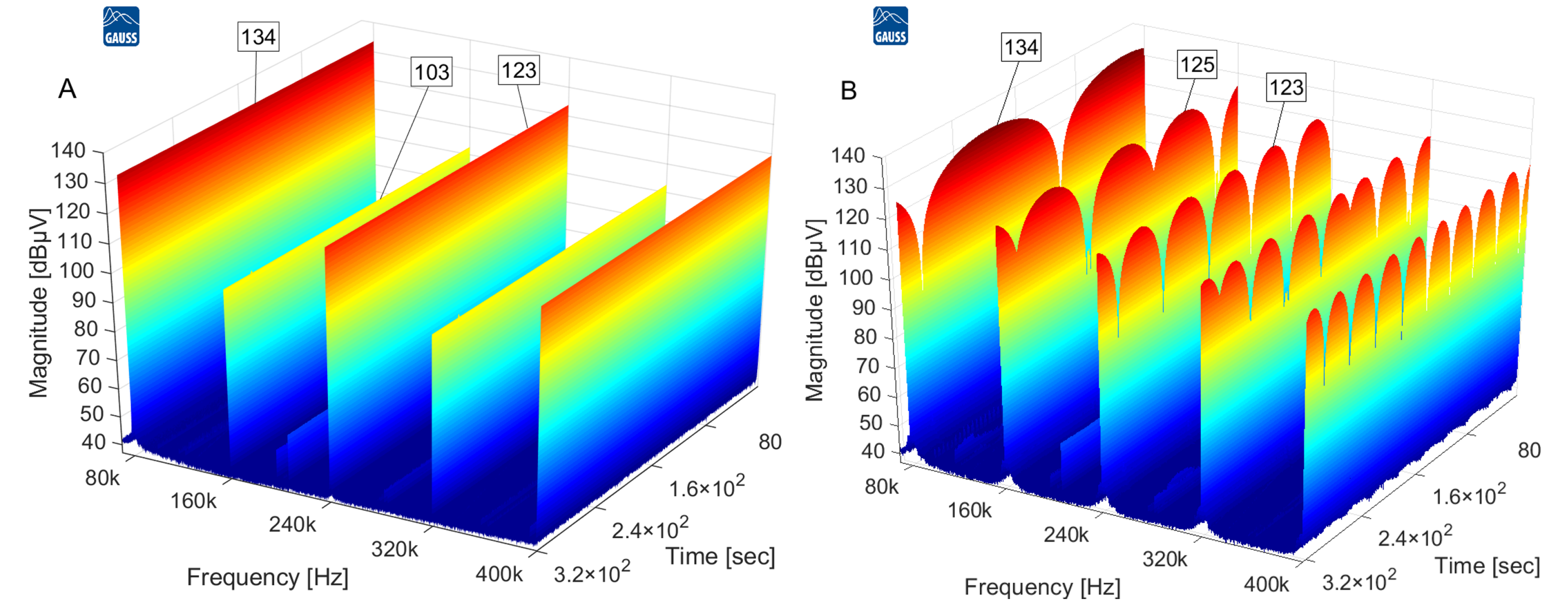
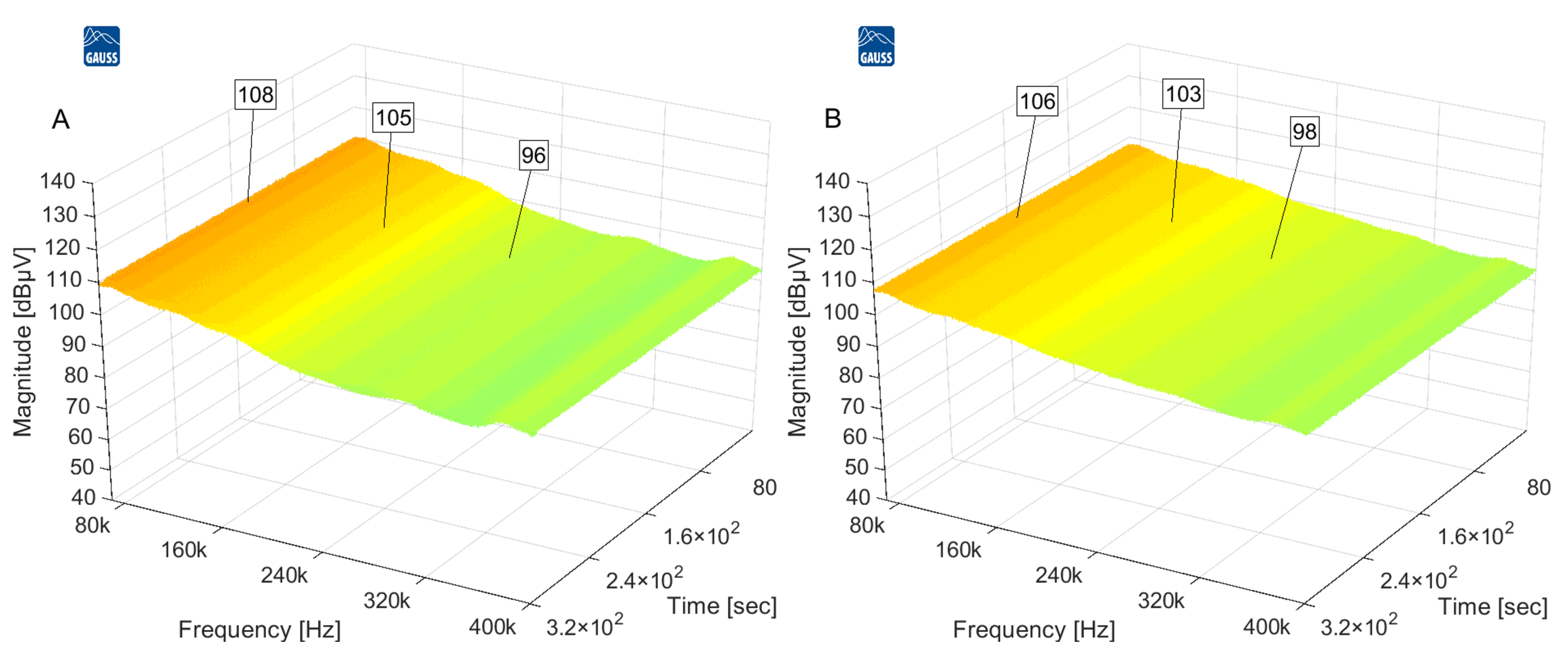
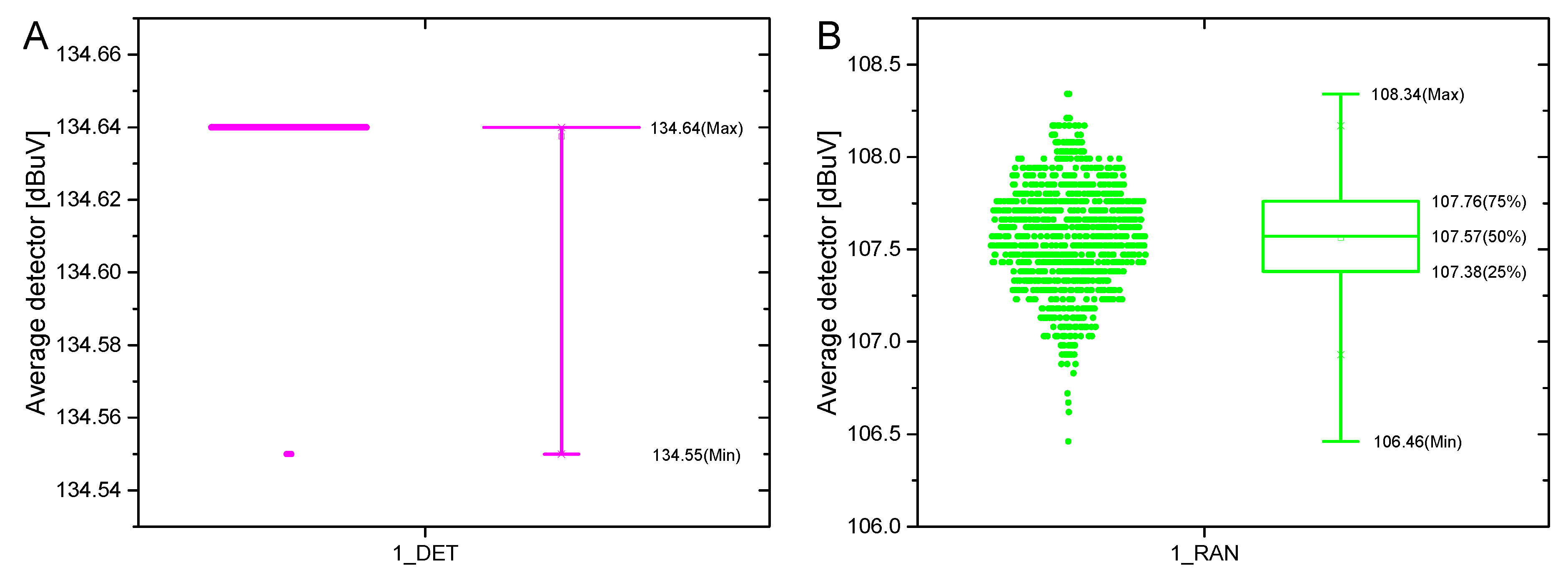
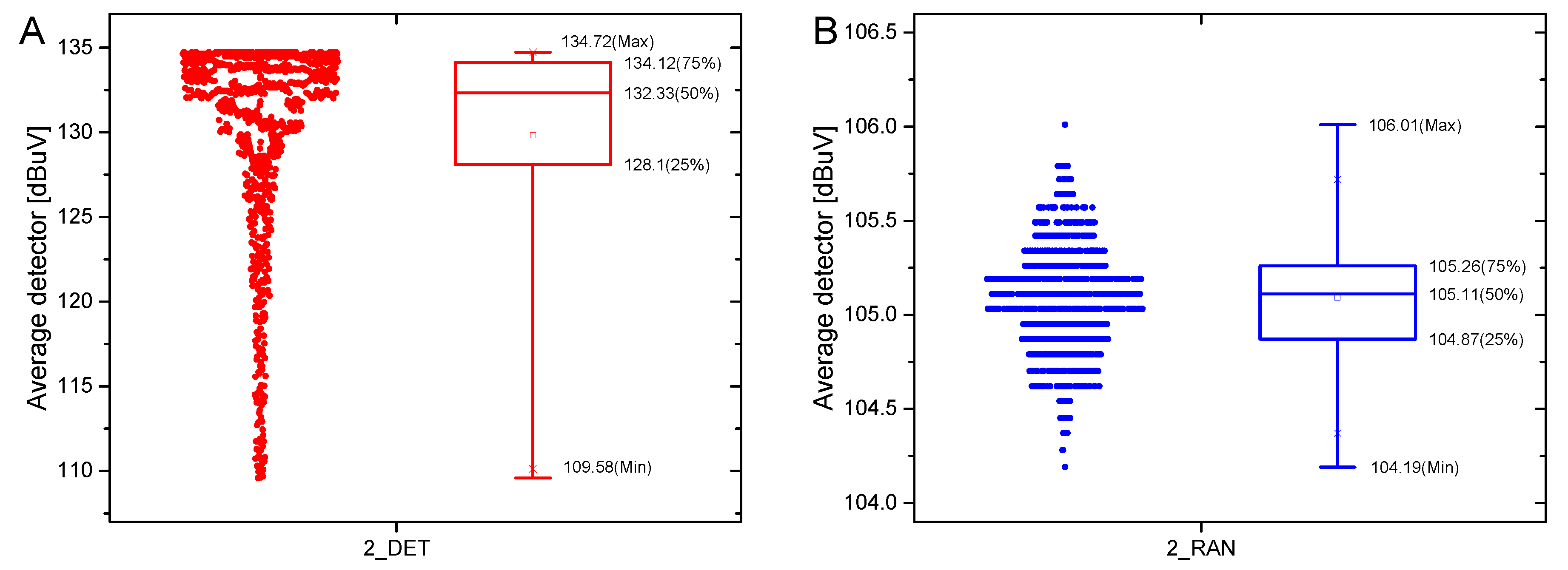
| Component/Function | Specification |
|---|---|
| Transistors type | IXGH40N60C2D1 |
| (max) | 40 A |
| 40 ns | |
| 180 ns | |
| Transistor Gate Drivers | HCPL-316J |
| Converter Power | 1800 W (max) |
| DC capacitors | 1500 F |
| Max DC voltage | 450 V |
| Load | sliding resistor 320 (max), 1.5 A (max) |
| Mean | Standard Deviation | Variance | Median | Minimum | Maximum | |
|---|---|---|---|---|---|---|
| 1_DET | 134.64 | 0.01 | 0.0002 | 134.64 | 134.55 | 134.64 |
| 1_RAN | 107.56 | 0.29 | 0.08 | 107.57 | 106.46 | 108.34 |
| 2_DET | 129.82 | 6.02 | 36.25 | 132.33 | 109.58 | 134.72 |
| 2_RAN | 105.09 | 0.28 | 0.08 | 105.11 | 104.19 | 106.01 |
© 2020 by the authors. Licensee MDPI, Basel, Switzerland. This article is an open access article distributed under the terms and conditions of the Creative Commons Attribution (CC BY) license (http://creativecommons.org/licenses/by/4.0/).
Share and Cite
Loschi, H.; Smolenski, R.; Lezynski, P.; Nascimento, D.; Demidova, G. Aggregated Conducted Electromagnetic Interference Generated by DC/DC Converters with Deterministic and Random Modulation. Energies 2020, 13, 3698. https://doi.org/10.3390/en13143698
Loschi H, Smolenski R, Lezynski P, Nascimento D, Demidova G. Aggregated Conducted Electromagnetic Interference Generated by DC/DC Converters with Deterministic and Random Modulation. Energies. 2020; 13(14):3698. https://doi.org/10.3390/en13143698
Chicago/Turabian StyleLoschi, Hermes, Robert Smolenski, Piotr Lezynski, Douglas Nascimento, and Galina Demidova. 2020. "Aggregated Conducted Electromagnetic Interference Generated by DC/DC Converters with Deterministic and Random Modulation" Energies 13, no. 14: 3698. https://doi.org/10.3390/en13143698
APA StyleLoschi, H., Smolenski, R., Lezynski, P., Nascimento, D., & Demidova, G. (2020). Aggregated Conducted Electromagnetic Interference Generated by DC/DC Converters with Deterministic and Random Modulation. Energies, 13(14), 3698. https://doi.org/10.3390/en13143698








